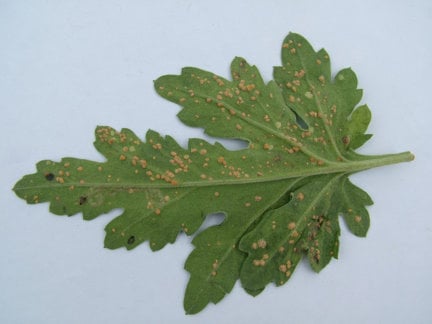
Quick facts
Common name - Chrysanthemum white rust
Scientific name - Puccinia horiana
Plants affected - Chrysanthemum
Main symptoms - Sunken yellow or brown spots on upper leaf surface, buff/white pustules on lower surface
Caused by - Fungus
Timing - Late summer and autumn
What is chrysanthemum white rust?
Caused by the fungus Puccinia horiana, white rust is a serious fungal disease of the foliage, spread by airborne spores. It originates in China and Japan, and first arrived in the UK on infected in 1963. Infection is favoured by cool, wet weather conditions, and the disease is found most commonly in late summer and autumn. Heavy attacks of white rust may stunt plants and reduce their vigour.
Symptoms
Plants affected by chrysanthemum white rust may exhibit the following symptoms:
- Pale yellow spots develop on the upper leaf surface
- These later become sunken and turn brown, and buff-coloured, lumpy spore pustules develop on the corresponding under surface
- The pustules turn white under conditions of high , as airborne spores are produced
- Severely affected leaves shrivel and turn brown, and plants are stunted and lack vigour
- Pustules are occasionally produced on the petals
Chrysanthemum is also sometimes affected by brown rust, caused by the closely related Puccinia chrysanthemi. This differs by producing dark brown pustules on the undersurface of the leaf, often in concentric circles. Brown rust is not as damaging to chrysanthemum as white rust.

Control
The RHS believes that avoiding pests, diseases and weeds by good practice in cultivation methods, selection, and encouraging or introducing natural enemies, should be the first line of control. If chemical controls are used, they should be used only in a minimal and highly targeted manner.
Non-chemical control
- Check plants regularly and remove and dispose of affected leaves
- Dispose of heavily infected plants
- Do not take from affected plants
- Monitor bought-in plants or cuttings closely for development of symptoms. If possible, keep bought-in material separate from any existing plants for several weeks to allow time for symptoms of any latent infections (see 'Biology' section below) to develop
- Hot water treatment of chrysanthemum stools (rootstocks) can give control of both white rust and chrysanthemum eelworm (nematode). All remaining foliage should be removed, the roots trimmed and the stools submerged for five minutes in water at 46°C (115°F). After this, the stools are plunged into cold water to cool them, followed by air-drying. It is important that the temperature is monitored closely – if too low, it is unlikely that good control will be achieved, whilst if it is significantly higher it will have an adverse effect on the plant and could even kill it
Fungicides
The RHS recommends that you don't use fungicides. Fungicides (including organic types) may reduce , impact soil health and have wider adverse environmental effects. If you do intend to use a fungicide, please read the information given in the link and download below to ensure that use, storage and disposal of the product is done in a responsible and legally compliant manner.
The products listed in the ‘Fungicides for gardeners’ document below are legally available for use by home gardeners in the UK. This information is provided to avoid misuse of legal products and the use of unauthorised and untested products, which potentially has more serious consequences for the environment and wildlife than when products are used legally. Homemade products are not recommended as they are unregulated and usually untested.
Download
Fungicides for gardeners (Adobe Acrobat pdf document outlining fungicides available to gardeners)
Link
Biology
The rust fungi are described as biotrophs; that is, they grow within the living tissues of the plant and extract from the cells. Although they do not kill tissues rapidly, heavy attacks by rusts can cause tissues to collapse and die prematurely and this is the case with white rust. Some rusts require two different plant hosts in order to complete their life-cycle, but white rust spends its entire life on chrysanthemum.
The buff-coloured pustules on the leaf undersides contain numerous spores called teliospores that remain embedded within the leaf. Under humid conditions the teliospores germinate to produce a second spore type called a basidiospore. It is the production of the minute basidiospores that causes the pustules to turn white, and it is these spores that are carried in air currents to create new infections when they land on other chrysanthemum leaves.
Infection is favoured by cool, wet or humid conditions. The disease is therefore most problematic in late summer and autumn, when suitable temperatures combine with prolonged leaf wetness caused by rain or morning dews.
The fungus cannot survive for extended periods on leaf debris, but can persist on overwintering plants or stools (rootstocks).
Like many rust diseases, white rust has a 'latent period', when infection of the plant has occurred but symptoms are not yet visible. Depending on environmental conditions this latent period can range from a few days to several weeks. Transport of symptomless but infected plants or is the main way in which the disease has been able to spread between continents.
Susceptibility: White rust does not affect any plants other than chrysanthemum. There are considerable differences in susceptibility between different chrysanthemum cultivars.






